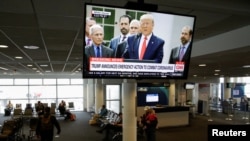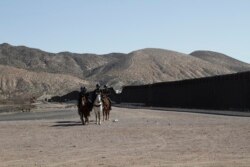By declaring the coronavirus pandemic a “national emergency” Friday, President Donald Trump is marshaling the full power of his office against the deadly virus after earlier measures fell short.
The Trump administration had already declared the coronavirus a public health emergency. The new national emergency declaration, made under the 1976 National Emergencies Act and the National Security Act, triggers more than 100 statutory authorities available to the president to combat the coronavirus, which is now wreaking havoc across the United States.
The proclamation authorizes the secretary of Health and Human Services to “waive or modify” certain requirements of government-funded health plans, such as Medicare and Medicaid, used by millions of Americans during the emergency.
$50 billion to help states
At the same time, Trump invoked the Stafford Disaster Relief and Emergency Assistance Act, which authorizes the president to direct the release of funds to states affected by a disaster or emergency.
Trump said the declaration will open up $50 billion in funds for states. All but three of 50 American states have reported coronavirus cases and more than two dozen have declared emergencies.
“It gives tremendous powers for things we need,” Trump told reporters at the White House after making the announcement. “It gives the kind of power we need to get rid of this virus.”
The Stafford Act enables the president to make a “major disaster declaration” and an emergency declaration, authorizing the Federal Emergency Management Agency (FEMA) to tap into billions of dollars in its Disaster Relief Fund.
The national emergency declaration gives Trump authority well beyond the ability to release emergency funds. The declarations range from waiving medical licensing requirements for doctors to allowing them to work across state lines to foregoing regulatory rules in order to approve a new coronavirus test "within hours."
Crude oil purchased
In an effort to aid the battered energy sector, Trump also directed the energy department to purchase "large quantities" of crude oil for the country's strategic reserve.
“No resource will be spared,” Trump said.
“When a president declares an emergency declaration, he at that moment has access to all of the laws that say in a national emergency the president can do X, whether or not those powers relate to the emergency at hand,” Elizabeth Goitein, director of the Brennan Center for Justice’s Liberty & National Security Program, said.
Some of the emergency authorities allow for a “reasonable and very measured” response to an emergency, such as suspending hospital regulations, Goitein said. At the same time, a national emergency declaration also empowers a president to take draconian measures in the name of national security. For example, a president could invoke a 1941 law to shut down the internet.
Border wall construction
Prior to Friday, Trump had made seven national emergency declarations, all but two in connection with imposing sanctions on foreign countries. Last year, Trump was criticized for declaring a national emergency in order to divert military funds to finance construction of a wall along the U.S.-Mexico border.
A national emergency declaration can only be overturned by an act of Congress. More than 30 national emergency declarations made over the past four decades remain in effect.
Nonemergency powers
In addition to exercising emergency powers, the president has certain nonemergency powers he has used during the coronavirus crisis. On Wednesday, Trump invoked the Immigration and Nationality Act of 1952 in suspending a large share of travel from Europe. He became the first president in more than 50 years to order a federally mandated quarantine of people exposed to the virus.
“The president doesn't have to declare an emergency in order to avail himself of that, but we know the president has already done that,” Goitein said.
Locking down communities or otherwise restricting the movements of large groups can conflict with constitutional rights of due process, according legal scholars.
At the state level, emergency declarations allow local authorities a wide range of powers — from requesting emergency funds from Washington to imposing so-called “social distancing measures,” including restricting travel, imposing curfews, dismissing schools, restricting public gatherings and implementing quarantines.










